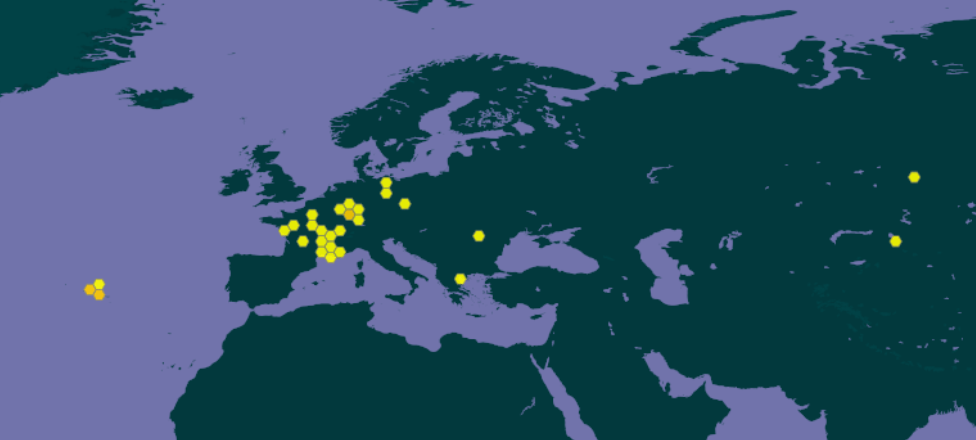 |
Sheep tick | Status LU: absent |
 |
Schofszeck | Status Eur.: established. |
 |
n/a | RA: ISEIA: C0. Harmonia+: n/a. |
 |
Schafzecke | Wikipedia:   | Wikispecies: | Wikispecies:  |
 |
n/a | Back to the list of invertebrates |
Contents
Report the species
→ Report Dermacentor marginatus to the National Museum of Natural History.
Important note
In 2015, six Dermacentor ticks were collected in SE-Luxembourg. Previously, these individuals had been identified as Dermacentor marginatus Leach, 1815. However, morphological re-investigation as well as DNA barcoding identified the specimens as Dermacentor reticulatus (Fabricius, 1794). Thus only D. reticulatus is known from Luxembourg (Weigand et al. 2020).
Brief description

In Central Europe the sheep tick is the most common species of the genus. It lives here only in heat islands and on sunny slopes or dry grasslands. Mammals, including humans, are preferred as hosts. The animals of the genus transmit tularemia (Francisella tularensis), Rocky Mountain spotted fever (Rickettsia richettsii), Q-fever (Rickettsia burneti), bovine anaplasmosis, puppy-babesiosis (Babesia canis) (Source: http://www.ijon.de/zecken/system.html#zecke).
It is one of the species that could be favoured by global warming, which would allow it to move northwards, but also upwards (Wikipedia contributors 2019).
Status and distribution in Luxembourg
The tick Dermacentor marginatus Leach, 1815 is absent from Luxembourg.
Risk assessment
ISEIA protocol
Following the morphological re-investigation as well as DNA barcoding that identified all the specimens as Dermacentor reticulatus (Fabricius, 1794) (Weigand et al. 2020), Dermacentor marginatus is considered absent from Luxembourg and was reassessed on 29 October 2020 to C0 (2+1+2+1). Initial assessment: C1 (2+1+2+1) (Ries et al. 2017: 68).
Harmonia+ protocol
Not assessed yet.
Worldwide distribution
Bibliography
- Direction de la Santé, 2016. Attention aux tiques! Comment se protéger? Dépliant. Luxembourg. URL: https://sante.public.lu/fr/prevention/tiques/
- GBIF, 2020. Dermacentor marginatus in GBIF Secretariat (2019). GBIF Backbone Taxonomy. Checklist dataset https://doi.org/10.15468/39omei [accessed 2020-03-05]
- Ries, C., A. Arendt, C. Braunert, S. Christian, A. Dohet, A. Frantz, G. Geimer, M. Hellers, J. A. Massard, X. Mestdagh, R. Proess, N. Schneider & M. Pfeiffenschneider, 2017. Environmental impact assessment and black, watch and alert list classification after the ISEIA Protocol of invertebrates in Luxembourg. Bull. Soc. Nat. luxemb. 119: 63-70. [PDF 360 KB]
- Weigand, A., J. Teixeira & S. Christian, 2020. First record of Hyalomma marginatum sensu stricto C.L. Koch, 1844 and distribution of Dermacentor reticulatus (Fabricius, 1794) (Acari, Ixodidae) in Luxembourg. Bull. Soc. nat. luxemb. 122 : 253-263.
- Wikipedia contributors, 2019. Dermacentor marginatus. Wikipédia, l’encyclopédie libre. URL: https://fr.wikipedia.org/wiki/Dermacentor_marginatus [accessed 2020-03-05]
Suggested citation of this webpage
Ries, C. & M. Pfeiffenschneider (Eds.), 2025. Dermacentor marginatus Leach, 1815. In: neobiota.lu - Invasive Alien Species in Luxembourg. National Museum of Natural History, Luxembourg. URL: https://neobiota.lu/dermacentor-marginatus/ [Accessed 2025-12-18].
Page content last updated on 2022-04-27. Last proofread by Caroline Grounds on 2019-12-10.


